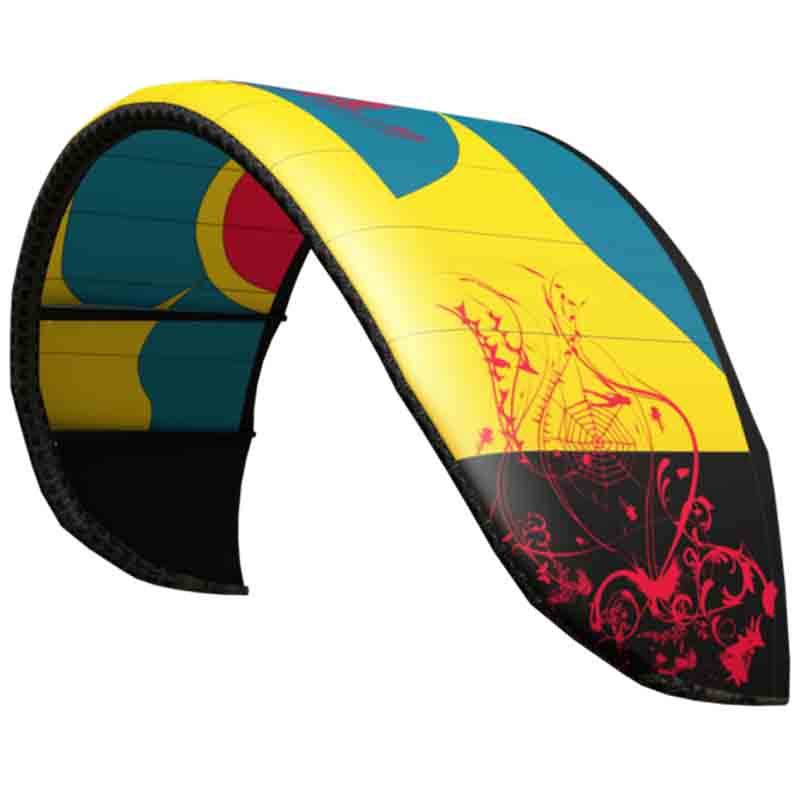When you purchase gear through links on our site, we may earn a small commission. Here’s why you can trust our tests and our affiliate partner.

JN’s original Prima Donna was a striking statement both aesthetically and in performance back in 2005. The friendly C-Kite with a daisy motif went through six (in)carnations over the 20-year lifespan of the model, but has always remained the freestyle weapon of choice in the JN range – the more recent versions being an open C shape, with swept tips and perhaps a less focused but more universal and friendly-to-use freestyler, with great handling and no punishing consequences when you crash – a perfect freestyle training sandbox for the aspirational rider some would say.
Two decades in, we were intrigued to see how they had augmented the Prima Donna for the mid 2020s, and with freestyle perhaps the most neglected sector currently. The good news is for long-term fans, there’s been some tweaking, but the formula hasn’t changed much. We’re still looking at a five-strut kite with a fifth line, which we see rarely across the industry currently. All attachment points are direct to the kite and no pulleys are present.
Materials employed are the usual high-quality Japanese Teijin cloth. The Prima Donna has a mixture of three and four core cloth to make up the canopy and a stiff Dacron with a stylish print across the tubes making up the struts and leading edge.
Tech-wise, there’s some quite unique features which are clearly designed to a specification, and not a price point. The Floating Batten Technology has been used across JN kites for years, and is now implemented on pretty much all inflatable wings. A profile shaped piece of cloth sits behind the strut to perfectly trim the canopy; it also allows for extra control when the kite has to run downwind fast. Another notable JN feature is the leading-edge segmentation, which is cleverly tailored to form a perfectly smooth shape, minimizing the number of segments required and significantly reducing drag.
What has always stood out with the Prima Donna across its entire lifespan is the handling. It’s a responsive kite to throw around and provides a gentle and progressive power delivery, ideal for learning more technical moves. The direct bar feedback has always been excellent, and remains so, both unhooked and hooked in; it’s a kite you never have to look at to know where it is, and it rarely overflies or tips out, which is impressive for a five-strut kite. You can have a truly terrible upside-down crash, and lose all orientation, pop up to the surface and the kite is waiting for you obediently.
Unhooking requires a little trimming to find the comfortable power level, as the kite has a high degree of angle of attack change over a short bar stroke due to the swept tips. Once set, the consistent power delivery is a joy for unhooking, and the way those floating struts react when you pop hard against them is quite unique and produces a consistent slack with a stable kite that maintains position in the window well. Those floating struts are magic in this instance.
In the spirit of modernity we chucked the kite around for some Big Air. The handling, solid air frame, and big angle of attack on sheet meant the Prima Donna can throw a respectable kite loop in sizes from 9m down, with even power through the maneuver, and a very consistent catch.
This playful handling characteristic, and high levels of depower available at the bar stroke, crosses over well into surf use, particularly if you’d require a kite with solid leeward tendency for onshore conditions. The smaller sizes are whippy enough to get you in position or out of trouble, and the kite will climb well in a tight spot with little preplanning.
Often a nostalgic trip down memory lane can be a disappointing one, but with the Prima Donna it’s the opposite. The crisp handling and improved versatility, as well as the extended wind range propel this unique kite into something that more than stands up against its peers. It’s rare in the modern marketplace that a kite relies entirely on its shape rather than bridling, but the steering feeling it produces is unique and difficult to emulate if pulleys are involved. If you were a freestyle-leaning individual who’d like a kite that handles like a Lotus, look no further.
